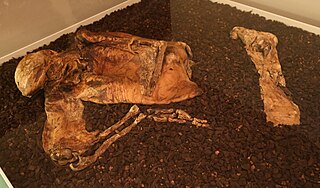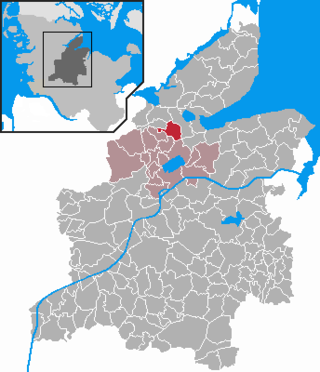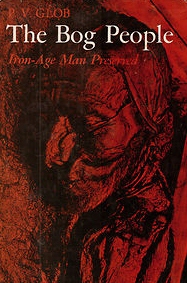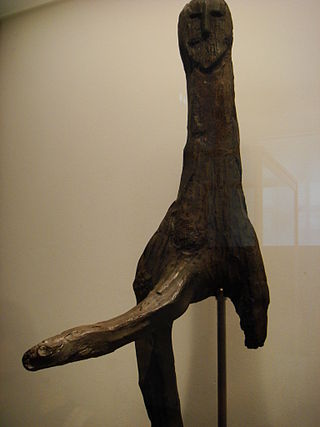
Lindow Man, also known as Lindow II and as Pete Marsh, is the preserved bog body of a man discovered in a peat bog at Lindow Moss near Wilmslow in Cheshire, North West England. The remains were found on 1 August 1984 by commercial peat cutters. Lindow Man is not the only bog body to have been found in the moss; Lindow Woman was discovered the year before, and other body parts have also been recovered. The find was described as "one of the most significant archaeological discoveries of the 1980s" and caused a media sensation. It helped invigorate study of British bog bodies, which had previously been neglected.

The Tollund Man is a naturally mummified corpse of a man who lived during the 5th century BC, during the period characterised in Scandinavia as the Pre-Roman Iron Age. He was found in 1950, preserved as a bog body, near Silkeborg on the Jutland peninsula in Denmark. The man's physical features were so well preserved that he was mistaken for a recent murder victim. Twelve years before his discovery, another bog body, Elling Woman, was found in the same bog.

A bog body is a human cadaver that has been naturally mummified in a peat bog. Such bodies, sometimes known as bog people, are both geographically and chronologically widespread, having been dated to between 8000 BCE and the Second World War. The unifying factor of the bog bodies is that they have been found in peat and are partially preserved; however, the actual levels of preservation vary widely from perfectly preserved to mere skeletons.

Yde Girl is a bog body found in the Stijfveen peat bog near the village of Yde, Netherlands. She was found on 12 May 1897 and was reputedly uncannily well-preserved when discovered, but by the time the body was turned over to the authorities two weeks later, it had been severely damaged and deteriorated. Most of her teeth and hair had been pulled from the skull. The peat cutting tools had also been reported to have severely damaged the body.

The Thorsberg moor near Süderbrarup in Anglia, Schleswig-Holstein, Germany, is a peat bog in which the Angles deposited votive offerings for approximately four centuries. It is the location of important Roman Iron Age finds, including early Elder Futhark runic inscriptions such as the Thorsberg chape, a Roman helmet, a shield buckle, and an early example of socks. The finds are of similar importance as the contemporaneous finds from Illerup and Vimose in Denmark.

The Haraldskær Woman is the name given to a bog body of a woman preserved in a bog in Jutland, Denmark, and dating from about 490 BC. Workers found the body in 1835 while excavating peat on the Haraldskær Estate. The anaerobic conditions and acids of the peat bog contributed to the body's excellent preservation. Not only was the intact skeleton found, but so were the skin and internal organs. Scientists settled disputes about the age and identity of this well preserved body in 1977, when radiocarbon dating determined conclusively that the woman's death occurred around the 5th century BC.

The Suebian knot is a historical male hairstyle ascribed to the tribe of the Germanic Suebi. The knot is attested by Tacitus in his 1st century AD work Germania, found on contemporary depictions of Germanic peoples, their art, and bog bodies.

Windeby I is the name given to the bog body found preserved in a peat bog near Windeby, Northern Germany, in 1952. Until recently, the body was also called the Windeby Girl, since an archeologist believed it to be the body of a 14-year-old girl, because of its slight build. Prof. Heather Gill-Robinson, a Canadian anthropologist and pathologist, used DNA testing to show the body was actually that of a sixteen-year-old boy. The body has been radiocarbon-dated to between 41 BC and 118 AD.

Osterby is a municipality in the district of Rendsburg-Eckernförde, in Schleswig-Holstein, Germany. It is mostly rural.
The Borremose bodies are three bog bodies that were found in the Borremose peat bog in Himmerland, Denmark. Recovered between 1946 and 1948, the bodies of a man and two women have been dated to the Nordic Bronze Age. In 1891, the Gundestrup cauldron was found in a nearby bog.

Stoneyisland Man is the name given to a bog body discovered in the Stoneyisland Bog, Gortanumera, County Galway, Ireland on 13 May 1929.
Damendorf Man is a German bog body discovered in 1900 in the See Moor at the village Damendorf in Schleswig-Holstein, Germany.
Alfred Dieck was a German archaeologist internationally recognised for the scientific studies on bog bodies and bog finds. Since the early 1990s, the results of his scientific work have been critically reviewed and found to be wrong in major parts.

Dr. Wijnand Antonius Bernardus van der Sanden is a Dutch archaeologist and prehistorian.

The Bog People: Iron-Age Man Preserved is an archaeological study of the bog bodies of Northern Europe written by the Danish archaeologist P.V. Glob. First published in 1965 by Gyldendal under the Danish title of Mosefolket: Jernalderens Mennesker bevaret i 2000 År, it was translated into English by the English archaeologist Rupert Bruce-Mitford and published by Faber and Faber in 1969. In 1966 it was translated into German by Thyra Dohrenburg and published by Winkler Verlag Munich under the title Die Schläfer im Moor.

The Braak Bog Figures are two wooden carvings discovered in 1947 in a peat bog in Braak, Schleswig-Holstein, Northern Germany. Part of a larger tradition of similar figures spanning the period from the Neolithic to the Middle Ages, they are human-like in appearance and have been carbon dated to the 2nd or 3rd century BCE; the Schleswig-Holstein state archaeology museum puts them as far back as 400BCE. Several hypotheses have been proposed to explain their function and what they may represent, from depictions of deities to ancestor worship.

Anthropomorphic wooden cult figurines, sometimes called pole gods, have been found at many archaeological sites in Central and Northern Europe. They are generally interpreted as cult images, in some cases presumably depicting deities, sometimes with either a votive or an apotropaic (protective) function. Many have been preserved in peat bogs. The majority are more or less crudely worked poles or forked sticks; some take the form of carved planks. They have been dated to periods from the Mesolithic to the Early Middle Ages, including the Roman Era and the Migration Age. The majority have been found in areas of Germanic settlement, but some are from areas of Celtic settlement and from the later part of the date range, Slavic settlement. A typology has been developed based on the large number found at Oberdorla, Thuringia, at a sacrificial bog which is now the Opfermoor Vogtei open-air museum.
Karl Schlabow was a German archaeologist, museum director and conservator with specialisations in textiles and in restoration of bog bodies. He founded the Neumünster Textile Museum. Since his death, his restorations have been called into question as overly aggressive.















